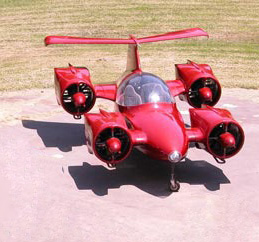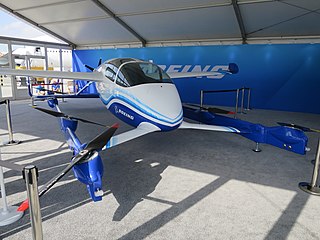
An aircraft is a vehicle that is able to fly by gaining support from the air. It counters the force of gravity by using either static lift or the dynamic lift of an airfoil, or, in a few cases, direct downward thrust from its engines. Common examples of aircraft include airplanes, helicopters, airships, gliders, paramotors, and hot air balloons.

A flying car or roadable aircraft is a type of vehicle which can function both as a road vehicle and as an aircraft. As used here, this includes vehicles which drive as motorcycles when on the road. The term "flying car" is also sometimes used to include hovercars and/or VTOL personal air vehicles. Many prototypes have been built since the early 20th century, using a variety of flight technologies. Most have been designed to take off and land conventionally using a runway. Although VTOL projects are increasing, none has yet been built in more than a handful of numbers.

Fly-by-wire (FBW) is a system that replaces the conventional manual flight controls of an aircraft with an electronic interface. The movements of flight controls are converted to electronic signals transmitted by wires, and flight control computers determine how to move the actuators at each control surface to provide the ordered response. Implementations either use mechanical flight control backup systems or else are fully electronic.
A vertical take-off and landing (VTOL) aircraft is one that can take off and land vertically without relying on a runway. This classification can include a variety of types of aircraft including helicopters as well as thrust-vectoring fixed-wing aircraft and other hybrid aircraft with powered rotors such as cyclogyros/cyclocopters and gyrodynes.

The Moller Skycar is a flying car with VTOL capability which has been under development by Paul Moller for over fifty years. As of 2023, the M400 has not achieved free flight.

The Bell Aerosystems Lunar Landing Research Vehicle was a Project Apollo era program to build a simulator for the Moon landings. The LLRVs were used by the FRC, now known as the NASA Armstrong Flight Research Center, at Edwards Air Force Base, California, to study and analyze piloting techniques needed to fly and land the Apollo Lunar Module in the Moon's low gravity environment.

A radio-controlled aircraft is a small flying machine that is radio controlled by an operator on the ground using a hand-held radio transmitter. The transmitter continuously communicates with a receiver within the craft that sends signals to servomechanisms (servos) which move the control surfaces based on the position of joysticks on the transmitter. The control surfaces, in turn, directly affect the orientation of the plane.

A miniature UAV, small UAV (SUAV), or drone is an unmanned aerial vehicle small enough to be man-portable. Smallest UAVs are called micro air vehicle.

Terrafugia is a Chinese-owned corporation, based in Woburn, Massachusetts, United States that is developing a roadable aircraft called the Transition and a flying car called the TF-X. The Transition and TF-X are designed to be able to fold their wings, enabling the vehicles to also operate as street-legal road vehicles.
The Dodge Intrepid ESX prototype cars are the result of the 1993 response by the Chrysler Corporation to a challenge by U.S. President Bill Clinton to produce a vehicle which was capable of meeting the demands of the modern consumer, while still achieving an unprecedented 80 miles per US gallon overall in fuel economy. The PNGV - Partnership for a New Generation of Vehicles project was aimed at The Big Three American car manufacturers.

An electric aircraft is an aircraft powered by electricity. Electric aircraft are seen as a way to reduce the environmental effects of aviation, providing zero emissions and quieter flights. Electricity may be supplied by a variety of methods, the most common being batteries. Most have electric motors driving propellers or turbines.
The following outline is provided as an overview of and topical guide to automobiles:

The Piaggio MP3 is a tilting three-wheeled scooter by Italian manufacturer Piaggio. First marketed in 2006, it is noted for its combination of two front wheels and a single rear wheel.

The Terrafugia Transition is a light sport, roadable airplane under development by Terrafugia since 2006.

The Aerial Reconfigurable Embedded System (ARES) was a concept for an unmanned VTOL flight module that can transport various payloads. The concept started as the TX (Transformer) in 2009 for a terrain-independent transportation system centered on a ground vehicle that could be configured into a VTOL air vehicle and carry four troops. ARES' primary function was the same as TX, to use flight to avoid ground-based transportation threats like ambushes and IEDs for units that don't have helicopters for those missions. It was to be powered by twin tilting ducted fans and have its own power system, fuel, digital flight controls, and remote command-and-control interfaces. The flight module would have different detachable mission modules for specific purposes including cargo delivery, CASEVAC, and ISR. Up to 3,000 lb (1,400 kg) of payload would be carried by a module.

The Israel Aerospace Industries Panther is a tilt-rotor unmanned aerial vehicle (UAV) produced by Israel Aircraft Industries in Israel.

The Vertical Take-Off and Landing Experimental Aircraft program is an American research project sponsored by the Defense Advanced Research Projects Agency (DARPA). The goal of the program is to demonstrate a VTOL aircraft design that can take off vertically and efficiently hover, while flying faster than conventional rotorcraft. There have been many previous attempts, most of them unsuccessful.
Krossblade Aerospace Systems is an aviation company founded in 2014 in Phoenix, Arizona, USA. The company is known for developing a 5-seat VTOL concept, SkyCruiser, hybrid vehicle for vertical take-off and landing, and for its drone/UAV prototype, named SkyProwler. Both aircraft employ the switchblade transformation mechanism to transform from a multirotor aircraft for vertical take-off and landing, to a pure winged aircraft, for rapid and efficient cruise.

The Boeing Passenger Air Vehicle (PAV) is an American electrical powered autonomous personal air vehicle prototype developed by the Boeing NeXt division of Boeing with the assistance of Aurora Flight Sciences.
The Jetson ONE is a type of personal aircraft known as an eVTOL. It is a 102-horsepower battery-operated aircraft with eight electric motors. The personal aircraft is produced by Swedish company Jetson Aero and it is manufactured and tested in Arezzo, Italy. To fly the single-seat aircraft, the operator does not need to have a pilot license nor have any special training. It is equipped with a parachute and it can operate even if one of its engines fails.















